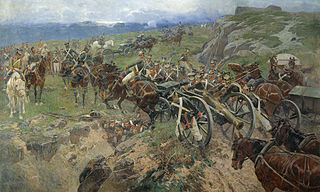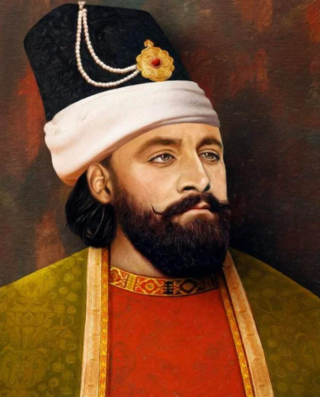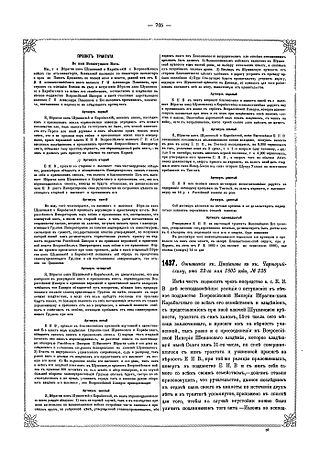
Sultan is a position with several historical meanings. Originally, it was an Arabic abstract noun meaning "strength", "authority", "rulership", derived from the verbal noun سلطة sulṭah, meaning "authority" or "power". Later, it came to be used as the title of certain rulers who claimed almost full sovereignty without claiming the overall caliphate, or to refer to a powerful governor of a province within the caliphate. The adjectival form of the word is "sultanic", and the state and territories ruled by a sultan, as well as his office, are referred to as a sultanate.

Qazax District is one of the 66 districts of Azerbaijan. It is located in the north-west of the country and belongs to the Gazakh-Tovuz Economic Region. The district borders the district of Aghstafa, and the Tavush Province of Armenia. Its capital and largest city is Gazakh. As of 2020, the district had a population of 98,400.

The Karabakh Khanate was a khanate under Iranian and later Russian suzerainty, which controlled the historical region of Karabakh, now divided between modern-day Armenia and Azerbaijan. In terms of structure, the Karabakh Khanate was a miniature version of Iranian kingship. The administrative and literary language in Karabakh until the end of the 19th century was Persian, with Arabic being used only for religious studies, despite the fact that most of the Muslims in the region spoke a Turkic dialect.

Molla Panah, better known by his pen-name Vagif, was an 18th-century Azerbaijani poet, statesman and diplomat. He is regarded as the founder of the realism genre in Azerbaijani poetry. He served as the vizier—the minister of foreign affairs—of the Karabakh Khanate during the reign of Ibrahim Khalil Khan.

The Russo-Persian War of 1804–1813 was one of the many wars between the Persian Empire and Imperial Russia, and began like many of their wars as a territorial dispute. The new Persian king, Fath Ali Shah Qajar, wanted to consolidate the northernmost reaches of his kingdom—modern-day Georgia—which had been annexed by Tsar Paul I several years after the Russo-Persian War of 1796. Like his Persian counterpart, the Tsar Alexander I was also new to the throne and equally determined to control the disputed territories.

The history of Azerbaijan is understood as the history of the region now forming the Republic of Azerbaijan. Topographically, the land is contained by the southern slopes of the Caucasus Mountains in the north, the Caspian Sea in the east, and the Armenian Highlands in the west. In the south, its natural boundaries are less distinct, and here the country merges with the Iranian Plateau.

The Ganja Khanate was a khanate under Iranian suzerainty, which controlled the town of Ganja and its surroundings, now located in present-day Azerbaijan.
Ibrahim Khalil Khan Javanshir (1732–1806) was the second khan of the Karabakh Khanate from the Javanshir family. He was the son and successor of Panah-Ali khan Javanshir.

Panah Ali Khan Javanshir was the founder and first ruler of the Karabakh Khanate under Persian suzerainty.
Javad Khan Qajar was a member Ziyadoghlu Qajar, a clan of the Qajar tribe, as well as the sixth and the last khan of the Ganja Khanate from 1786 to 1804 before it was lost to Russia.

The khanates of the Caucasus, also known as the Azerbaijani khanates, Persian khanates, or Iranian khanates, were various administrative units in the South Caucasus governed by a hereditary or appointed ruler under the official rule of Iran. The title of the ruler was khan, which was identical to the Ottoman rank of pasha. Following the assassination of Nader Shah in 1747, internal chaos erupted in Iran, particularly in the South Caucasus, where semi-autonomous khanates emerged as a result of the lack of a centralized government. The khans neither had territorial or religious unity, nor an ethnic/national identity. They were mostly interested in preserving their positions and income.
Fatali Khan or Fath Ali Khan of Quba was a khan of the Quba Khanate (1758–1789) who also managed to dominate the Derbent, Baku, Talysh and Shirvan Khanates, as well as the Salyan Sultanate during much of his reign.

The Kalmyk Khanate was an Oirat khanate on the Eurasian steppe. It extended over modern Kalmykia and surrounding areas in the North Caucasus, including Stavropol and Astrakhan. During their independence, the Kalmyks both raided and allied with Russia in turn, engaging in numerous military expeditions against the Crimean Tatars, the Ottoman Empire, neighboring Muslim tribes, and the highlanders of the North Caucasus. The Khanate was annexed by the Russian Empire in 1771.

The Derbent Khanate was a Caucasian khanate that was established in Afsharid Iran. It corresponded to southern Dagestan and its center was at Derbent.

The Sultanate of Elisu, also known as Elisou or Ilisu, was a sultanate in the 18th and 19th centuries.

Shamshadil was a sultanate in the South Caucasus established in 1747. It was located in what is now northeastern Armenia and northwestern Azerbaijan.

Kurakchay treaty is a contract confirming the integration of the Karabakh Khanate into the Russian Empire. The signing ceremony took place on May 14, 1805, in a Russian military camp on the banks of the Kurekchay river, not far from Ganja. The agreement was signed by Ibrahim Khalil Khan and Commander-in-Chief of Georgia, Infantry General Pavel Tsitsianov.
Mirza Jamal Javanshir was a secretary and historian under the Karabakh Khanate and later the Russian Empire. He is principally known as the author of the Persian-language historical chronicle Tarikh-e Qarabagh.
Shoragel, Shuragel, Shorayel, or the Sultanate of Shoragel was a sultanate established around 1747, in the period of Afsharid dynasty in Persia, and it often was part of the Erivan Khanate. Its area was 1037.91 versts (1181.16 km²), and the population mainly consisted of Turkic tribes.

Borchaly sultanate — was a feudal state that existed until the middle of the XVIII century on the territory of the historical region of Borchaly.















